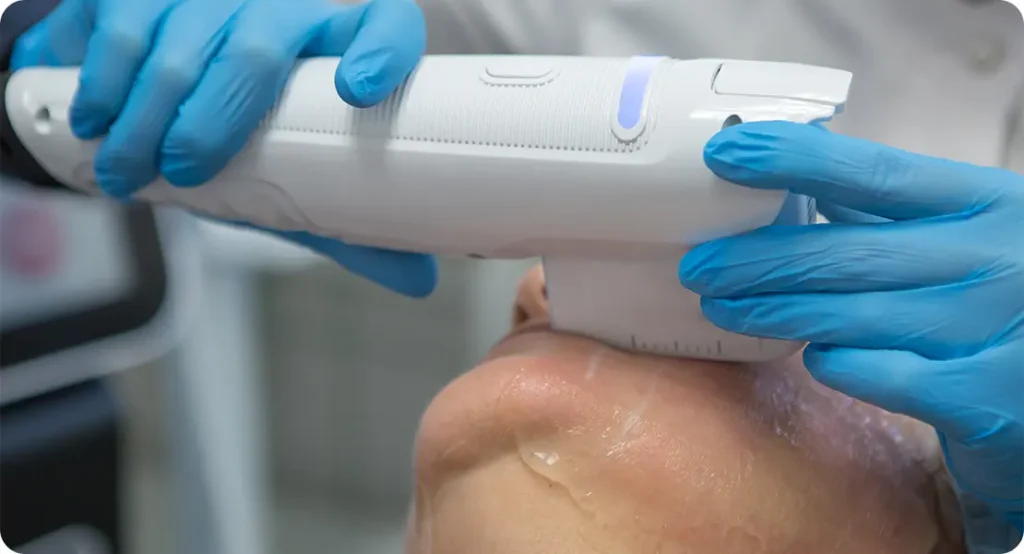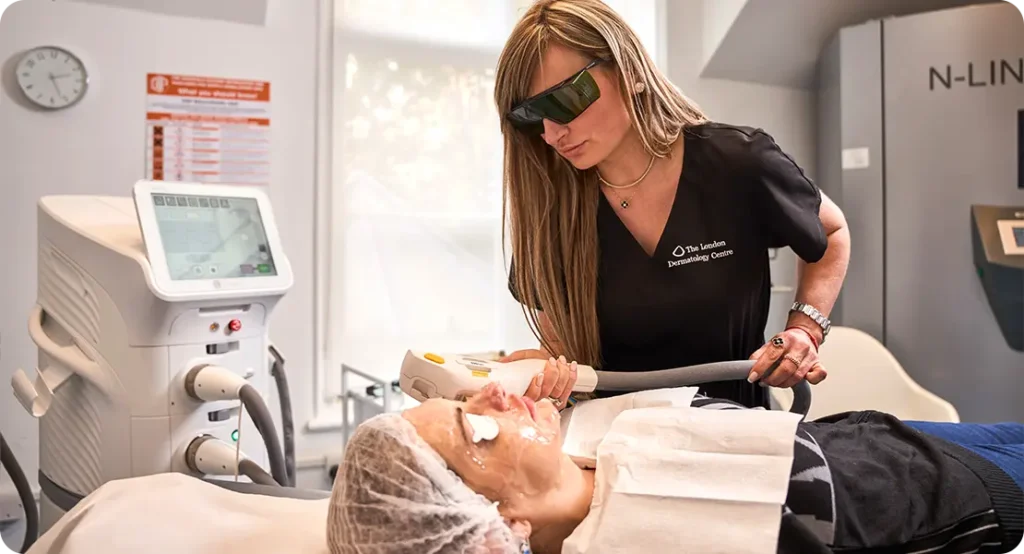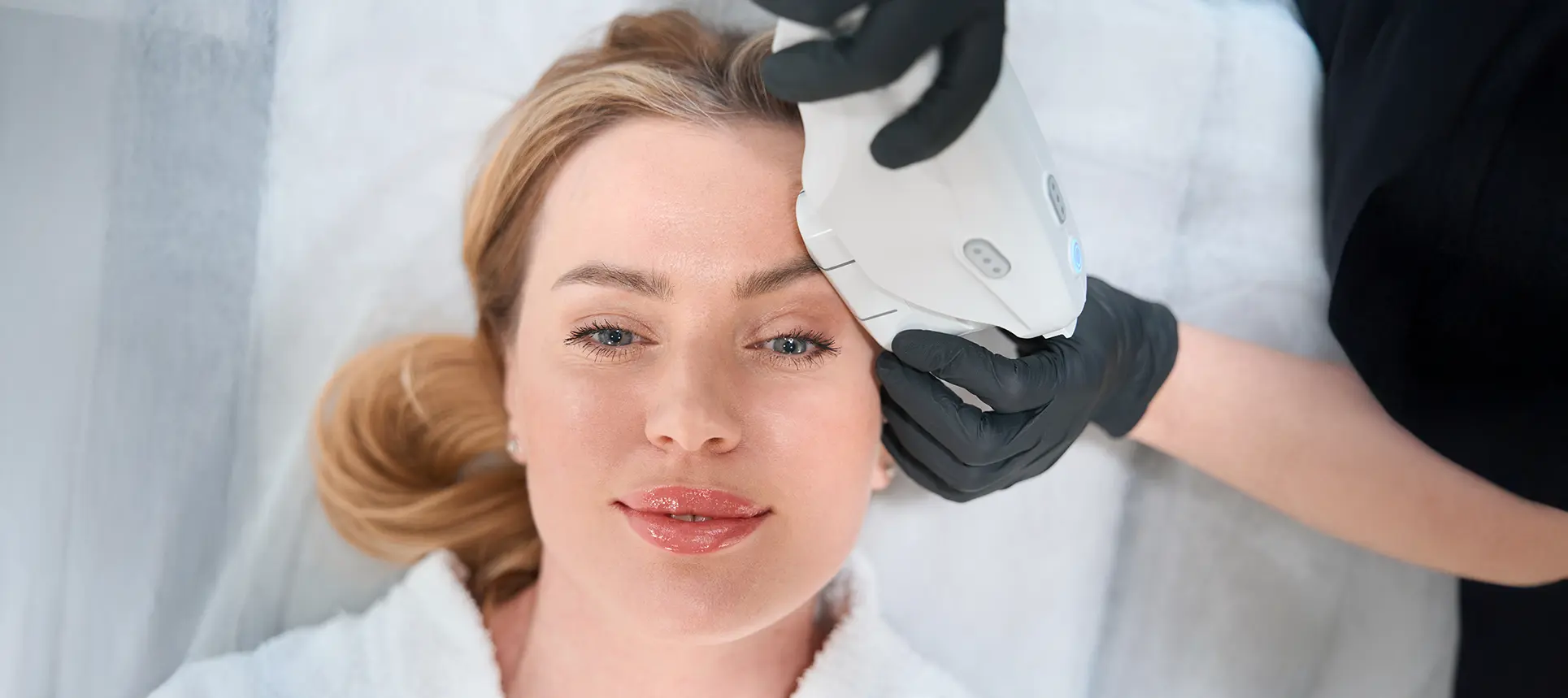In the world of dermatology, laser treatments are a popular and effective solution for a variety of skin concerns. One such treatment that has gained considerable attention for its versatility and effectiveness is the Fraxel laser.
Fraxel is a non-invasive laser treatment that targets the skin’s surface and deeper layers to improve a variety of skin issues, including acne scars, fine lines, sun damage, and uneven skin texture. Unlike traditional laser treatments, Fraxel works by creating tiny, controlled wounds in the skin, stimulating the body’s natural healing processes. This process results in smoother, clearer, and younger-looking skin over time.
In this expert guide, I will explain what Fraxel laser treatment in London can treat, how it works, and why it’s one of the most effective laser treatments for skin rejuvenation. By the end of this article, you’ll have a clear understanding of whether Fraxel is the right treatment for you and your skin concerns.
What Is Fraxel Laser?
Fraxel is a fractional laser treatment that uses a combination of both ablative and non-ablative technology. Unlike traditional lasers that treat the entire surface of the skin, Fraxel divides the treatment area into thousands of tiny “fractions,” or microscopic columns.
These fractional columns of light penetrate the skin at different depths, targeting both superficial and deeper layers. The treatment stimulates the skin’s natural healing response by encouraging collagen and elastin production.
The result? Clearer, smoother skin with fewer signs of aging, scars, and damage. Fraxel lasers are effective in treating both the epidermis (outer layer) and the dermis (deeper layer) of the skin, making them versatile for a wide range of skin concerns.
What Can Fraxel Laser Treat?

Fraxel lasers are incredibly versatile and can help you tackle a variety of skin concerns. The results you get will depend on the settings your dermatologist chooses, as these are personalised to your skin type and concerns. Here’s a closer look at what Fraxel can do for you:
1. Acne Scars
Acne scars are one of the most common reasons people turn to Fraxel. If you’ve ever struggled with breakouts, you might have noticed scars left behind, ranging from shallow marks to deeper indentations. Fraxel helps by encouraging your skin to produce new collagen, repairing damaged tissue and smoothing your skin’s surface.
How it works: Fraxel targets both the outer layer of your skin (epidermis) and the deeper layer (dermis), breaking down scar tissue and stimulating the growth of healthy skin.
What you can expect: With treatment, you’ll notice your scars becoming less noticeable over time. Both depressed (atrophic) and raised (hypertrophic) scars can improve. Keep in mind, you may need several sessions to see the best results.
2. Sun Damage and Hyperpigmentation
If you’ve spent a lot of time in the sun, you might have developed sunspots, age spots, or uneven pigmentation. Fraxel can help restore a more even, radiant skin tone by targeting excess melanin and encouraging your skin to regenerate.
How it works: The laser gently breaks down pigmented areas, allowing your skin to naturally remove dark spots and replace them with fresh, healthy skin.
What you can expect: Over a few sessions, you’ll notice your skin tone becoming more even, and freckles or age spots appearing less prominent. Your skin will look brighter and more refreshed.
3. Fine Lines and Wrinkles
As you age, your skin loses collagen and elastin, which can lead to fine lines and wrinkles. Fraxel can help you restore some of that youthful bounce. It encourages new collagen production, which smooths out fine lines and helps your skin feel firmer.
How it works: By penetrating the dermis, Fraxel promotes the creation of collagen in the areas that need it most.
What you can expect: Fraxel can make mild to moderate wrinkles less visible, especially around delicate areas like under your eyes or at the corners of your mouth. Deeper wrinkles may require multiple treatments for the best results.
4. Uneven Skin Texture
If your skin feels rough or uneven, Fraxel can help you get a smoother, more polished look. Factors like sun damage, aging, or even certain skin conditions like rosacea can leave your skin bumpy or coarse.
How it works: Fraxel uses a fractional approach to stimulate cell turnover, encouraging your skin to shed old, damaged cells and replace them with healthier ones.
What you can expect: Over time, your skin will feel softer, look more even, and your pores may appear smaller. This is especially beneficial if you’ve struggled with rough patches from acne or sun exposure.
5. Skin Resurfacing for Ageing Skin
If you feel your skin is losing its youthful glow, Fraxel can give it a visible refresh without the need for invasive procedures. It helps restore elasticity, reduces sagging, and improves overall tone.
How it works: By stimulating collagen and elastin production, Fraxel rejuvenates your skin from within, helping it feel firmer and look more vibrant.
What you can expect: You’ll notice a fresher, brighter complexion and a reduction in age spots or sun damage. Your skin can regain a healthy, youthful radiance.
6. Stretch Marks
Stretch marks, whether from pregnancy, weight changes, or growth spurts, can make your skin feel uneven. Fraxel can improve both the texture and appearance of these marks.
How it works: The laser creates tiny, controlled injuries in the affected areas, which triggers your body to produce new collagen and gradually repair the skin.
What you can expect: Over several sessions, stretch marks may become less noticeable, blending more naturally with the surrounding skin. Red and white stretch marks alike can show significant improvement.
How Fraxel Laser Works for Different Skin Types

Fraxel isn’t a one-size-fits-all treatment it’s highly versatile and can be customised to suit your unique skin type, tone, and concerns. Dermatologists adjust the settings carefully to ensure the safest and most effective results for every individual. Here’s how Fraxel works for different skin types:
1. For Darker Skin Types (Fitzpatrick IV–VI)
If you have darker skin, you might worry about laser treatments because of the risk of hyperpigmentation. The good news is that Fraxel can be safe and effective for your skin when used correctly. Your dermatologist will adjust the laser’s intensity and coverage to minimise the risk of pigment changes, while still targeting issues like melasma, acne scars, or uneven skin tone.
What you can expect: With the right settings, you can see smoother, more even skin without the common side effects that sometimes come with lasers on darker skin tones.
2. For Fairer Skin Types (Fitzpatrick I–III)
If your skin is lighter, you might notice more redness after treatments or be more prone to sun damage. Fraxel works well for fairer skin, targeting sun spots, fine lines, and wrinkles. By stimulating collagen production, it helps your skin look smoother and more youthful, with minimal risk of hyperpigmentation.
What you can expect: You can enjoy brighter, fresher-looking skin and a reduction in the signs of sun damage or early aging, all while keeping your skin tone even.
The Fraxel Laser Treatment Process
Getting Fraxel treatment can feel a little intimidating at first, but knowing what to expect at each step can help you feel more confident. Here’s a detailed look at how the process works and what you can do to prepare and recover effectively:
1. Consultation
Your Fraxel journey begins with a thorough consultation with your dermatologist. During this appointment, they’ll examine your skin, ask about your medical history, and listen to the concerns you want to address whether it’s acne scars, sun damage, fine lines, or uneven texture.
This is also your chance to ask questions about the procedure, recovery time, and expected results. Your dermatologist will explain what the treatment can realistically achieve for your skin type and will personalise the settings to target your specific concerns. By the end of the consultation, you’ll have a clear plan tailored just for you.
2. Pre-Treatment Care
Before your Fraxel session, your skin will be carefully cleansed to remove makeup, dirt, and oils. A topical numbing cream is usually applied to minimise discomfort during the procedure.
For areas that are particularly sensitive, such as around the eyes or mouth, your dermatologist may administer a local anaesthetic to ensure you feel as comfortable as possible. They’ll also give you instructions on how to prepare your skin in the days leading up to your session, which may include avoiding certain skincare products or sun exposure.
3. During the Treatment
During the actual treatment, the Fraxel laser is passed over the target areas. You may feel a tingling, prickling, or gentle heat sensation, but it should never be painful.
Depending on the depth of the treatment, your dermatologist may use additional cooling techniques, such as a fan or cooling device, to keep your skin comfortable. The procedure is relatively quick, with small areas taking only a few minutes, while larger areas may take longer. You’ll be able to see that the laser is working as it stimulates your skin’s natural healing process, encouraging collagen production and cell renewal.
4. Aftercare and Recovery
After your treatment, it’s normal for your skin to appear red, feel warm, or even slightly swollen. These reactions are temporary and usually improve within a few hours to a couple of days, depending on the intensity of your session.
Your dermatologist will provide personalised aftercare instructions, which may include:
- Using gentle moisturisers to keep your skin hydrated.
- Avoiding harsh skincare products or exfoliants for a few days.
- Applying broad-spectrum sunscreen diligently to protect your healing skin from UV damage.
- Avoiding direct sun exposure, hot showers, or strenuous exercise for a short period, if recommended.
Following these instructions closely can help you achieve the best results while minimising potential side effects. Over the next few days, you may notice mild flaking or peeling as your skin renews itself. This is a positive sign that the treatment is working. With time, your skin will look smoother, brighter, and more refreshed.
Pro Tips for a Smoother Recovery
- Drink plenty of water to keep your skin hydrated from the inside out.
- Use a gentle, fragrance-free cleanser during the first few days.
- Avoid picking at peeling skin to prevent irritation or pigmentation issues.
- Consider scheduling follow-up sessions as recommended by your dermatologist for optimal results.
Post-Treatment Care and Recovery
Knowing what to expect after your Fraxel treatment can help you feel more comfortable and confident as your skin heals. Here’s a detailed guide to post-treatment care and the recovery process:
Redness and Swelling
After your session, it’s normal for your skin to look a little red and feel warm, similar to a mild sunburn. You may also notice some swelling in the treated areas. This usually settles within a few hours to a couple of days, depending on the intensity of your treatment and your skin type.
Tip: Applying a cool compress or soothing gel can help reduce discomfort and calm your skin.
Peeling and Flaking
In the days following treatment, you may notice peeling or flaking as your skin sheds old, damaged cells. This is a completely normal part of the healing process and a sign that your skin is regenerating.
Tip: Avoid picking or scratching your skin, as this can lead to irritation or uneven pigmentation. Instead, let it exfoliate naturally, and use a gentle, hydrating moisturizer to support the process.
Avoid Sun Exposure
Protecting your skin from the sun is crucial after Fraxel treatment. Direct sun exposure can increase the risk of hyperpigmentation and slow down healing. Dermatologists usually recommend avoiding sunlight for at least two weeks post-treatment and applying a broad-spectrum sunscreen whenever you step outside.
Tip: Consider wearing a wide-brimmed hat or seeking shade when outdoors to further protect your healing skin.
Results and Long-Term Improvements
While you may notice some immediate improvements, the full results of Fraxel usually become visible after 4–6 weeks. As your body continues to produce collagen over the following months, your skin’s texture, tone, and overall appearance will keep improving.
Tip: For the best results, follow up with your dermatologist for recommended touch-up sessions or maintenance treatments. Consistent skincare, including hydration and sun protection, will also help you enjoy long-lasting benefits.
Is Fraxel Laser Right for You?
Fraxel can be a fantastic option if you want to improve your skin’s texture, tone, and overall appearance without undergoing surgery. It’s designed to help a wide range of skin concerns, from fine lines and wrinkles to acne scars and sun damage.
However, Fraxel isn’t suitable for everyone. You might want to hold off on treatment if:
- You currently have active acne or rosacea in the area you want treated.
- You are pregnant or breastfeeding.
- You have certain skin conditions, such as eczema or psoriasis, which could be irritated by the laser.
The best way to know for sure if Fraxel is right for you is to have a detailed consultation with a qualified dermatologist. During this appointment, your dermatologist will assess your skin, discuss your goals, and create a personalised treatment plan tailored specifically to your needs. This ensures you get the safest and most effective results possible.
FAQs About Fraxel Laser Treatment:
1. How long does a Fraxel laser session take?
A typical Fraxel session lasts between 30 minutes to an hour, depending on the size of the area being treated. Smaller areas like under the eyes may be quicker, while larger areas such as the full face take longer. Your dermatologist will give you a clear idea during your consultation.
2. Does Fraxel treatment hurt?
Most people feel a tingling or gentle heat during the procedure, but it shouldn’t be painful. A numbing cream is applied beforehand, and for sensitive areas, your dermatologist may use a local anaesthetic or cooling techniques to ensure your comfort.
3. How many sessions will I need?
The number of treatments varies depending on your skin concerns. For mild issues, 2–3 sessions may be enough, while deeper scars, sun damage, or stretch marks may require 4–6 sessions. Your dermatologist will create a personalised plan based on your goals.
4. Can Fraxel treat all skin types?
Yes! Fraxel can be customised for all skin types, but settings differ based on your skin tone. Darker skin types (Fitzpatrick IV–VI) require careful adjustments to minimise pigment changes, while fairer skin (Fitzpatrick I–III) can safely target sun damage, fine lines, and wrinkles.
5. What should I do before my Fraxel treatment?
Before your session, you’ll need to cleanse your skin and avoid certain skincare products or sun exposure as advised by your dermatologist. Using sunscreen regularly in the weeks leading up to treatment is important to protect your skin.
6. What is the recovery like?
After treatment, it’s normal to experience redness, swelling, or warmth, similar to a mild sunburn. Your skin may peel or flake over the next few days as it regenerates. Most people return to their normal activities within 1–3 days, though intensity depends on your treatment depth.
7. When will I see results?
Some improvement may be visible immediately, but full results appear after 4–6 weeks, as your skin continues to produce collagen. Continued improvements can occur over several months, giving your skin a smoother, more youthful appearance.
8. Can Fraxel treat acne scars?
Yes. Fraxel is highly effective for both depressed (atrophic) and raised (hypertrophic) acne scars. By stimulating collagen production, it helps repair damaged tissue and smooth out your skin’s surface over multiple sessions.
9. Are there any side effects?
Common side effects include redness, swelling, mild discomfort, and temporary peeling. Serious complications are rare, especially when treatment is performed by a qualified dermatologist. Following your aftercare instructions is key to minimising risks.
10. Is Fraxel right for me?
Fraxel can be ideal if you want to improve skin texture, tone, and overall appearance without surgery. However, it’s not suitable if you have active acne or rosacea, are pregnant or breastfeeding, or have certain skin conditions like eczema or psoriasis. A consultation with your dermatologist will help determine if it’s the right option for you.
Final Thoughts: Is Fraxel Laser Right for You?
Fraxel laser is an effective and safe option for treating a wide range of skin concerns, from acne scars to sun damage and fine lines. With its ability to stimulate collagen production and improve skin texture, it’s a great choice for anyone looking for non-invasive skin rejuvenation.
By working with a skilled and experienced dermatologist, you can ensure that the treatment is personalised to your skin’s needs, delivering results that will leave you looking refreshed and youthful.
If you’re considering Fraxel laser treatment in London, book a consultation with us at the London Dermatology Centre. Our expert dermatologists will create a personalised treatment plan tailored to your skin’s unique needs. With the right care and follow-up sessions, you can enjoy smoother, clearer, and more radiant skin that looks naturally rejuvenated and maintains its youthful glow over time.
References:
1. Gold, M.H. (2010). Update on fractional laser technology. Journal of Clinical and Aesthetic Dermatology, 3(6), pp. 22–29. https://pmc.ncbi.nlm.nih.gov/articles/PMC2921736/
2. Ptaszek, B. (2025). ‘The use of a fractional laser in acne scar treatment: A systematic review’. Journal of Dermatological Treatment. Available at: https://pubmed.ncbi.nlm.nih.gov/40566567/
3. Chiu, R. J., et al. (2007). ‘The Fraxel™ 1550-nm Glass Fiber Laser Treatment’. Lasers in Surgery and Medicine, 39(7), pp. 528-533. Available at: https://www.sciencedirect.com/science/article/abs/pii/S1064740607000466
4. Haykal, D., et al. (2024). ‘Advancements in Laser Technologies for Skin Rejuvenation’. Journal of Cosmetic Dermatology, 23(3), pp. 1234-1240. Available at: https://onlinelibrary.wiley.com/doi/10.1111/jocd.16514
5. Naein, F. F., et al. (2012). ‘Fractional CO2 Laser as an Effective Modality in Treatment of Striae Distensae’. Journal of Cosmetic and Laser Therapy, 14(5), pp. 228-232. Available at: https://pmc.ncbi.nlm.nih.gov/articles/PMC3698650/
